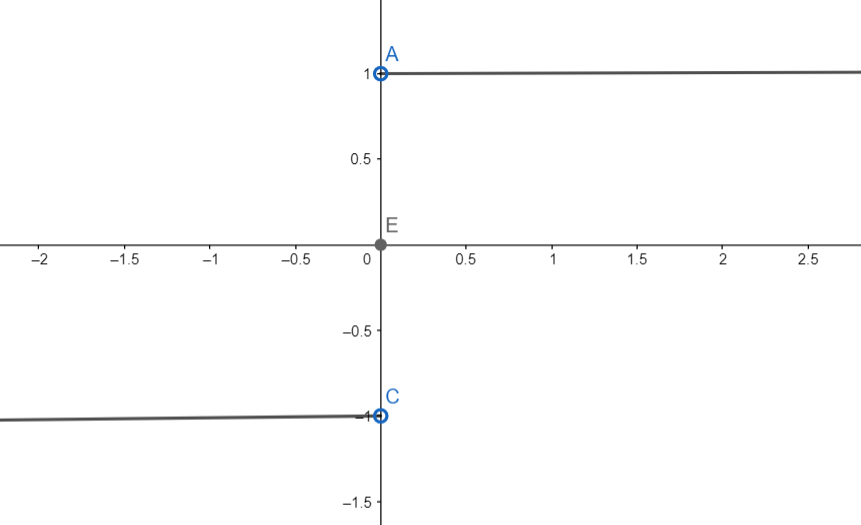
Define signum function. Draw the graph and write its domain and range.
Answer
508k+ views
Hint: We will look at the definition of signum function and with the help of that we will plot graph. And then from looking at the graph we can find the value of the domain which will be the values of x for which the function is defined and the range will be the possible values of the function.
Complete step by step solution:
Let’s first look at the definition of signum function.
Signum function is often defined simply as 1 for x > 0 and -1 for x < 0. And for x = 0 it is 0.
$f\left( x \right)=\left\{ \begin{align}
& \frac{\left| x \right|}{x},\text{ if }x\ne 0 \\
& 0,\text{ if }x=0 \\
\end{align} \right.$
$f\left( x \right)=\left\{ \begin{align}
& 1,\text{ if }x>0 \\
& 0,\text{ if }x=0 \\
& -1,\text{ if }x<0\text{ } \\
\end{align} \right.$
Now let’s look at the graph of signum function.

In the graph we can see that point A and B are open, hence these points are not included. So at x = 0, point E is defined and it gives 0.
From the above graph and the given function also we can see that the domain is the value of x for which the function is defined, it is defined for all values of x.
Therefore the domain is $\left( -\infty ,\infty \right)$
The range is the possible value of y, we can see from the graph that the values can be -1, 0, and 1.
Therefore, range is $\left\{ -1,0,1 \right\}$
Note: In the solution we have given two forms of signum function, one can break the value of $\left| x \right|$ for x>0 and x<0, and then put the equation to convert it in the second form. So, one should not be confused with such issues.
Complete step by step solution:
Let’s first look at the definition of signum function.
Signum function is often defined simply as 1 for x > 0 and -1 for x < 0. And for x = 0 it is 0.
$f\left( x \right)=\left\{ \begin{align}
& \frac{\left| x \right|}{x},\text{ if }x\ne 0 \\
& 0,\text{ if }x=0 \\
\end{align} \right.$
$f\left( x \right)=\left\{ \begin{align}
& 1,\text{ if }x>0 \\
& 0,\text{ if }x=0 \\
& -1,\text{ if }x<0\text{ } \\
\end{align} \right.$
Now let’s look at the graph of signum function.

In the graph we can see that point A and B are open, hence these points are not included. So at x = 0, point E is defined and it gives 0.
From the above graph and the given function also we can see that the domain is the value of x for which the function is defined, it is defined for all values of x.
Therefore the domain is $\left( -\infty ,\infty \right)$
The range is the possible value of y, we can see from the graph that the values can be -1, 0, and 1.
Therefore, range is $\left\{ -1,0,1 \right\}$
Note: In the solution we have given two forms of signum function, one can break the value of $\left| x \right|$ for x>0 and x<0, and then put the equation to convert it in the second form. So, one should not be confused with such issues.
Recently Updated Pages
Master Class 12 Business Studies: Engaging Questions & Answers for Success

Master Class 12 Economics: Engaging Questions & Answers for Success

Master Class 12 English: Engaging Questions & Answers for Success

Master Class 12 Maths: Engaging Questions & Answers for Success

Master Class 12 Social Science: Engaging Questions & Answers for Success

Master Class 12 Chemistry: Engaging Questions & Answers for Success

Trending doubts
What is meant by exothermic and endothermic reactions class 11 chemistry CBSE

Which animal has three hearts class 11 biology CBSE

10 examples of friction in our daily life

One Metric ton is equal to kg A 10000 B 1000 C 100 class 11 physics CBSE

1 Quintal is equal to a 110 kg b 10 kg c 100kg d 1000 class 11 physics CBSE

Difference Between Prokaryotic Cells and Eukaryotic Cells




